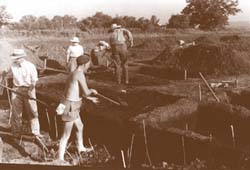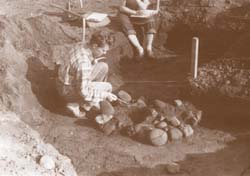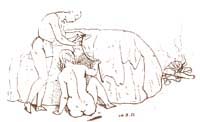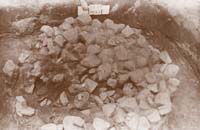
 |
Archaeological excavation at the Zimmerman site, 1947. |
The excavation of the Zimmerman site (the location of the former Grand Village of the Kaskaskia), began with an explicit problem in mind: what were the archaeological complexes associated with the early historic tribes. (James A. Brown, 1961)![]()
The Zimmerman site is believed to be the location of the Grand Village of the Kaskaskia, which was occupied intermittently by the Kaskaskia and Peoria tribes from 1673 to 1691 and may have been re-occupied by the Peoria in the early 1700s. However, the site's history is complicated by the fact that it also contains the remains of several prehistoric occupations. Archaeologists from the Illinois State Museum and the University of Chicago conducted a joint excavation at Zimmerman in 1947, and the La Salle County Historical Society sponsored three seasons of excavation beginning in 1970. Additional work has been undertaken at the site in connection with the state's acquisition of the property in 1991 and its designation as the Grand Village of the Illinois Historic Site. The site was named for the Clara Zimmerman family, former owners of some of the land on which the site is located.
An historic occupation at Zimmerman called the Danner culture is thought to be affiliated with the Illinois Indians. Danner is recognized by its association with several distinct types of shell-tempered pottery (e.g., Danner Grooved Paddle) and a variety of French trade goods including brass beads, coiled brass hair ornaments, a brass compass, blue glass beads, iron ax heads, iron knives, and an iron tomahawk head. The site also yielded an abundance of traditional artifacts including several kinds of chipped-stone tools (small triangular arrowheads, bifacial knives, scrapers, drills), ground-stone tools (sandstone pendant, sandstone abrader, granite pipe), and tools made of bone or antler (mat needles, awls, shaft wrench, projectile points, bison-scapula hoes, turtle-shell bowl). Other items were native adaptations of European materials, including arrowheads and ornaments (tinkling cones) that were cut and reformed from brass kettles.
![]()
Hoe blade made from the scapula (shoulder blade) of a bison (ISM 1947.56; length=371mm). Recovered from archaeological excavations at the Zimmerman site, a Kaskaskia Illinois village (1673-1722) located in La Salle County, Illinois.
Line drawing of bison-scapula hoe, composed of the shoulder blade of a bison lashed to a wood handle. (drawing by Frederick Wilson, Minnesota Historical Society, St. Paul)
![]()
Archaeologist Elaine A. Bluhm excavating a rock concentration at the Zimmerman site, 1947.
Excavators discovered the remains of oval to elongate houses and other residential structures at the Zimmerman site. They found several rock concentrations composed of fire-cracked granitic cobbles that may have been associated with small, dome-shaped sweat lodges.
![]()
Woman entering a sweat lodge at a Hidatsa Indian village in the northern Great Plains. (sketch by Rudolf Kurz, 1851)
Excavators also found traces of subsurface pits. Some pits were used for food storage and trash disposal, while others were roasting pits evidently used to cook large tubers like the macopine. Plant remains confirm that corn, beans, and watermelons were important Illinois crops. Animal remains indicate that bison provided over half the total meat supply, although elk, deer, bear, dog, and fish were also consumed.![]()
![]()
Roasting pit (Feature A-33) being excavated at the Zimmerman site, 1947.
|
|
Copyright © 2000 Illinois State Museum




